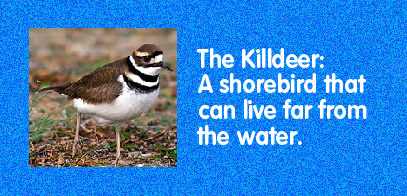This season's articles (Excerpted from our printed newsletter):
The Killdeer
Although Killdeer are technically in the family of shorebirds, they are unusual shorebirds in that they often nest and live far from the water. Few golf courses or extensive vacant lots are without their breeding pairs of Killdeer. They like to nest in open ground and gravel is a favorite. They may use a slight depression in the gravel to hold the eggs, but they don't line it at all, or line it only with a few stones. Since there is no structure to stand out from its surroundings, a Killdeer nest blends into the background. Furthermore, the speckled eggs themselves look like stones.
 The Killdeer is a bird that gets along well with man, taking advantage of whatever habitat man provides or preserves, field or unpaved road or rooftop. It also appreciates the water's edge though, and it can often be found on the shore of ponds and lakes.
The Killdeer is a bird that gets along well with man, taking advantage of whatever habitat man provides or preserves, field or unpaved road or rooftop. It also appreciates the water's edge though, and it can often be found on the shore of ponds and lakes.
The adult characteristics are very distinctive. They have brown upper feathers and white undersides. Their brown head has a black band between the eyes, white "eyebrows" and black bands around the upper chest. They have a sharp, black bill, long legs, and a long tail. Male and female look the same.
Killdeer breed from Alaska to Newfoundland south. Their diet consists of mainly insects but they will also eat berries and crustaceans.
The Killdeer may sometimes distract predators from his nest by pretending to be injured. It performs a conspicuous distraction display, dragging itself as it mortally wounded, often on one foot, its wings seemingly broken and its rusty tail fanned toward the intruder. This feigning of injury is effective in luring the predator away from the eggs or young, at which point the bird then "recovers" and flies off, calling loudly.
Each year, In February, the Killdeer appears inthe Midwest, long before the robins begin to sing. It's also the migrant to leave in fall, remaining in Iowa until November.
Feeder Frenzy: Tray/Platform Feeders
A tray/platform (either name is correct) feeder is any flat, raised surface onto which bird food is spread. Trays attract most species of birds, particularly ground feeders; some are available with roofs to help keep the seeds drier from the elements.
The platform should have a mesh bottom with plenty of drainage holes to prevent water accumulation from rain or melting snow. A tray feeder could be hung from a tree or pole, mounted atop a pole, or set near the ground. If the feeder is placed near the ground it is open to all creatures as well as birds.
These feeders are available either in wood or recycled material. Some of them come with optional legs for ground feeding, many have removable bottom screening for easy cleaning and some are made with a bottom "stretcher board" for easy mounting onto a pole.
Any of the Wildbird & Backyard seed mixes would be suitable for a platform feeder, as well as a single seed choice such as black oil sunflower or safflower seed.
Back to current newsletter













